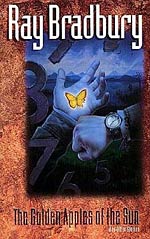
![]() Rhondak101
Rhondak101
2/7/2012
![]()
Ray Bradbury's The Golden Apples of the Sun and Other Stories (1990) contains short stories from two of his previous works: one by the same name, published in 1953, and R is for Rocket, published in 1962. This reprint contains all of the stories from R is for Rocket and eighteen of the original twenty-two stories in the previous edition of Golden Apples. (The two collections had a couple of stories in both.)
The stories from the original Golden Apples demonstrate the range of Bradbury's writing. Many of them were originally published in mainstream publications, such as The New Yorker, Esquire, The Saturday Evening Post, and Colliers, and don't demonstrate any science fiction or fantasy elements. They do, however, convey a sense of wonder and otherness. Because of this, many of them were recycled for HBO's 1980s series, Ray Bradbury Theater. The strongest of these stories seem very current. "I See You Never" recounts the deportation of a Mexican immigrant who had overstayed his visa. "Sun and Shadow" is set in Mexico and explores a poor homeowner's objection to his house being used as "local color" in the photos of an American fashion photographer. The protagonist in "The Murderer" reacts to modern technology in the same way that many of us wish we could. The murderer in "The Fruit in the Bottom of the Bowl" worries about leaving evidence behind.
The weaker stories do seem very dated. Many of them have ambiguous time settings, placed in either our past or an isolated "land that time forgot" setting. For this reason, I did not like "The Great Wide World Over There" and "Powerhouse." I found "The Big Black and White Game" particularly puzzling. In telling about a baseball game between the white and black employees of a resort hotel, Bradbury displays that type of 1940s racism that doesn't think it is racist. He clearly wants to denounce the overt racism of the white women in the story, but then he has the following passage, which I think is supposed to be complimentary:
How easily the dark people had come running first, like those slow-motion deer and antelopes in those African moving pictures, like things in dreams. They came like beautiful brown, shiny animals that didn't know that they were alive, but lived. And when they ran and put their easy, lazy, timeless legs out and followed with their big sprawling arms and loose fingers, and smiled blowing in the wind, their expressions did not say, 'Look at me run, look at me run.' No, not at all. Their faces dreamily said 'Lord, but it's sure nice to run...'
Many reviews of "The Big Black and White Game" commend Bradbury for writing a story about racial tensions. I also learned that the story was chosen for Best American Short Stories in 1945. This story provides a good example of the way a dated story can jar a reader. I had trouble reconciling the author of Fahrenheit 451 to the author of this story. (This experience is making me add The Martian Chronicles to my list. I'm ashamed to say that I've never read it, but I've always seen it characterized as a book that exposes prejudice and racism.)
The new edition of Golden Apples does not indicate that the reader is moving from the earlier The Golden Apples of the Sun to R is for Rocket, but it does include Bradbury's 1962 introduction to the latter book. He writes: "This is a book then by a boy who grew up in a small Illinois town and lived to see the Space Age arrive, as he hoped and dreamt it would." This "book" is much more cohesive than the earlier section containing the Golden Apples stories. It tells about rocket ships, space colonies, and time travel (intended and unintended, physical as well as mental). Many of the stories deal with family and space travel: "R is for Rocket" and "Rocket Man" charmingly demonstrate the sacrifices that families make when one of their members decides to travel to the stars; "The Strawberry Window" shows how colonists cope with being away from home. "The Sound of Thunder" is Bradbury's eerie story that presents the "butterfly effect" though time travel. William Contento's index lists this story as the most reprinted and anthologized science fiction story. (See http://www.philsp.com/homeville/isfac/0start.htm) "Frost and Fire" is a novelette-length story of survivors who crash on a planet with extreme temperatures and high radiation. At the beginning of the story, a boy, Sim, is born with all his faculties and senses intact. He has a clear racial memory telling him that he will grow and live and die in eight days. Bradbury's structure and premise are strong here, and I found this story much more satisfying than many of the others.
In general, this collection seems uneven. There are great stories, weak stories, and dated stories—some are genre fiction; others are more mainstream. The R is for Rocket part is certainly stronger. The stories are better, and they seem to fit together. However, three of my four favorites come from the Golden Apple part of the book. These are "Sun and Shadow" and "The Fruit at the Bottom of the Bowl," which are not science fiction stories at all, and "The Murderer," which centers on technology in the "future" and seems very much like now. This book has made me want to read more Bradbury.